#Standing Bear and Cary reunited finally!
Explore tagged Tumblr posts
Text
[ Send “cloth blindness” for a starter where my muse is wearing a blindfold. Sent by @inthisfire-ifindrain. featuring @standingxbear ]

"You dumb sons of bitches, you think you're hot shit? I know you! I was you!" Cary had been going on for a good while in the middle of the raider camp, tied up and blindfold. Of course he had worked through his gag and if there had been any raiders left alive, Cary probably wouldn't be.
Standing Bear needed a minute. It was one thing to take on a gang of raider with your friend. Fiona was more willing to get her hands dirty than West these days, sometimes Betty tagged along, but he was lock step with West about the research and clinic and all those things about modded guns and robots that Standing Bear, and probably Fiona, too, kind of stop listening to when they went on...
It was one thing to kill a bunch of raiders. It was another to find your teenage best friend their prisoner. Someone he hadn't seen in nearly 40 years. Apart from a little gravely texture, Cary Robinson sounded exactly the same. The news that he had been a raider was a little surprising. But... after the White Legs War, well...
Standing Bear was overwhelmed. Would Cary even want to know him? He had found Two Rivers years ago... His own sister didn't want to remember that life. Nevermind he'd spent 30 years looking for her. Nevermind that he loved her, that he knew she still loved her big brother. You couldn't just erase that. You couldn't just forget that. Bear wrote to her. But she never wrote back.
"You think I haven't killed? C'mon, I could take any of you in a knife fight. Bunch of chicken shit punks... Hello?" Finally Cary figured out he wasn't actually speaking to anyone, hands tied behind him, ankles chained to a large piece of arched rebar in a road side slab of concrete in the middle of the camp. It was getting dark, the fire cast odd shadows on Cary's face.
Standing Bear cleaned off his knives against the dirty bandana he took from one of the corpses. A little too diligently. He was nervous. No, he was scared of getting rejected again. He was scared of Cary not remembering him, or their band, their friendship. He was scared of seeing that same cold look on his sister's face: I have a new life now, why should I need you?
"Talk to him," Standing Bear whispered to Fiona, off handedly as if he were too busy to do so. Normally, he would have insisted, or just been the one to handle the sociable situation as Fiona was a little more blunt. "He's a friend. But-- Nevermind, just make sure he's not a threat."

#he's a friend: fiona#inthisfire-ifindrain#inthisfireifindrain#thread#Standing Bear and Cary reunited finally!#Yea this is all from Bear's POV but next thread I'll get into it with Cary. Just gonna keep it on one blog tho LOL
3 notes
·
View notes
Text
‘The Pollack Rule’ By Donald Liebenson
It’s Valentine’s Day, and TCM’s fancy turns to love in all its many splendored-ness, from the fantasy THE ENCHANTED COTTAGE (‘ 45) to the tearjerker THE WAY WE WERE (’73). I was present when the latter film’s director, Sydney Pollack, made a provocative observation during a press junket while promoting his remake of SABRINA. He said that you could have a good romantic movie about two people who fall in love or fall out of love, but you couldn’t have a good romantic movie about two people already in love. On Valentine’s Day, and throughout the rest of the month, TCM is offering several classic film romances that bear him out and a few that may be exceptions to Pollack’s rule.
IT HAPPENED ONE NIGHT (‘34)

“Do you love her?”
“YES! But don’t hold that against me, I’m a little screwy myself.”
Frank Capra’s 1934 screwball romance (one of the few comedies to win the Academy Award for Best Picture, along with the other top four categories) is all about conflict: Clark Gable is a disgraced newspaper man who needs a big story. Claudette Colbert is a woman who provides it for him when she runs away to reunite with the fiancée of whom her father disapproves. He’s a man of the people; she’s a spoiled heiress who for all her millions doesn’t know how to dunk (her donut in coffee, that is). Thrown together on the road, they bicker and banter until finally love emerges triumphant.
THE LADY EVE (‘41)

“You certainly are a funny girl for anybody to meet who`s just been up the Amazon for a year.''
Fleecing Charles Pike (Henry Fonda), “the tall, backward boy who's always toying with toads and things” is easy enough for card shark Jean (Barbara Stanwyck). The hard part is falling in love with her mark. But that’s only the beginning of Preston Sturges’ breakneck farce that seamlessly combines high wit and low (albeit expertly timed) pratfalls.
CITY LIGHTS (‘31)

“Yes, I can see now.”
Perhaps the main conflict here is Charlie Chaplin opting to make a silent film three years after sound came in. But this rapturous love story makes for his lovely swan song to the silent era. If you can keep a dry eye in the iconic climactic moment when the formerly blind flower seller realizes that the tramp standing before her was her benefactor who helped restore her sight, you are made of sterner stuff than I am.
THE SMILING LIEUTENANT (‘31)
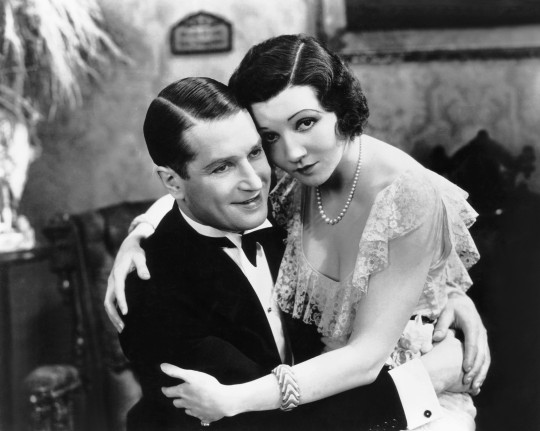
“When we like someone, we smile. But when we want to do something about it, we wink.”
Greater minds than mine (I guess that takes up most of you) have tried to convey the unbearable lightness of being that is the Lubitsch Touch. The last seven minutes of this charming pre-Code Lubitsch gem should do the trick as Maurice Chevalier is flabbergasted by the “jazz up your lingerie” transformation of the heretofore sheltered princess (Miriam Hopkins) he was forced to marry.
SINGIN’ IN THE RAIN (‘52)
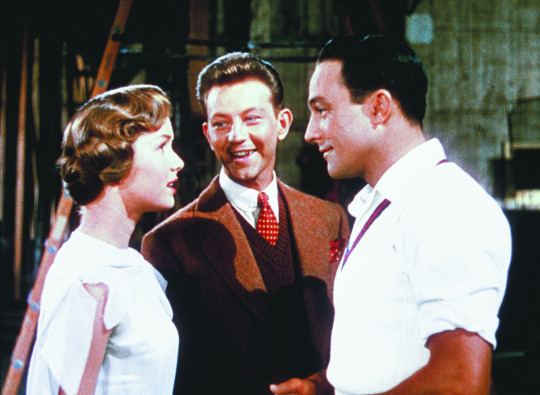
“You sure look lovely in the moonlight, Kathy.”
Stanley Donen’s glorious musical in which Debbie Reynolds’ aspiring actress Kathy Selden was meant for Gene Kelly’s silent screen star Don Lockwood. But can their love survive the machinations of Don’s screen partner, Lina Lamont, who can’t act, can’t sing and can’t dance but who is determined to remain hitched to his star?
GUESS WHO’S COMING TO DINNER (‘67)

“You're two wonderful people who happened to fall in love and happen to have a pigmentation problem.
Dr. John Prentice (Sidney Poitier) and Christina Drayton (Katharine Houghton) are an interracial couple in love when the film opens, and they are Switzerland-bound to be married. In this groundbreaking 1967 Oscar-winner, the conflict comes from expected places (“There'll be 100 million people right here in this country who will be shocked and offended and appalled”), but also unexpected: Christina’s own father (Spencer Tracy), who up to this point had considered himself a liberal.
THE PALM BEACH STORY (‘42)

“Sex always has something to do with it, dear.”
Although not as transgressive as a pregnant Betty Hutton in THE MIRACLE OF MORGAN’S CREEK, Preston Sturges’ screwiest comedy hits the ground running with a potent censor-baiting conflict, namely that Claudette Colbert schemes to divorce the struggling architect husband she loves (Joel McCrea) to marry a multi-millionaire who can finance one of her husband’s radical projects. As the besotted millionaire, Rudy Vallee gets the lion’s share of the film’s best lines (“That’s one of the tragedies of this life - that the men who are most in need of a beating up are always enormous.”)
NINOTCHKA (‘39)

“Chemically, we're already quite sympathetic.”
Lovers don’t get more star-crossed than a Communist Russian envoy (Greta Garbo) and a capitalist Parisian playboy (Melvyn Douglas). But like Paris at night, this comedy deftly directed by Lubitch sparkles and glitters. The script, co-written by Billy Wilder, nimbly navigates grim reality and romantic fantasy, as witness a drunken Ninotchka’s pleas to the “people of the world”: “I know, wars will wash over us, bombs will fall, all civilization will crumble, but not yet, please. Wait, wait; what's the hurry? Let us be happy. Give us our moment.”
THE AWFUL TRUTH (‘37)

“In the spring, a young man's fancy lightly turns to what he's been thinking about all winter.”
Married couple Cary Grant and Irene Dunne love each other, so much so that they are willing to go to hilarious lengths to sabotage each other’s new romances after they get divorced over suspicions of infidelity. THE AWFUL TRUTH anticipates by one year Howard Hawks’ BRINGING UP BABY, in which Katharine Hepburn’s character indelibly defines the ethos of screwball comedy: “All that happened, happened because I was trying to keep you near me. I just did anything that came into my head.”
And that’s what love is all about; at least in the movies.
138 notes
·
View notes
Text
Ballerina/Leap! Character appreciation: Odette Milliner.

Well...Wow! She's one piece of art and one of the most beloved characters in the fandom. Since her phisycal appearance, to her character and story plot she's great.
Of course in the beginning you know she was a dancer, you know something happened to her to make her a lame person.
The first time we met her, it's complicated to know why she rescues Félicie and why then she gets out her from the opera. Well, maybe she wants to stay out of trouble. She knew very well that she ran the risk saving an orphan, of being chased by her since then.
She's a person with many secrets. She tries the best of hidding everything related with all her past. Like many characters of movies and books, she's dissapointed with life and doesn't want to know nothing about nothing. We see her exhausted, frightened with Régine 's presence, and discouraged.
I can see along the movie that she's afraid of any relationship she can link and then break with others. It's obvious that she wants at any cost to avoid Mérante. She has been chastened with past experiences about her social relationships, she has become a cold and lonely person.
At this point... Which of us didn't felt like that at some moment of our lifes? The characters in Ballerina/Leap! have one influence on us. At least I feel identified with Félicie and some people want to be like her. We feel more identified with Camille when we see her trying to please her mother but also trying to be honest. Odette is one character, wheathered that lives like some kind of zombie. Like many people, she can't anymore.
One theory I have is that there are some many special people that can take out the best in us. Félicie is the case with Odette. Suddenly she becomes a good companion for her, and then, Odette starts to bring out her great personality.
She's smart, witty and brilliant. She also has a clever and playful sense of humour. She is a very quiet character and I can’t blame her for that. As a dancer she might be someone that doesn't need to say to much to be understood. Also quiet and shy people has been considerated smart ones.
Also like Félicie she got many guts and is very experienced about life because of her own experiences. To have lived many years as a poor caretaker under the comand of an abusive employeer, the fact of having to stand by herself among the dangerous streets of Paris, with a limp, with to few to eat, to few hours of resting, makes her not only an underrated and discreet survivor but also a warrior.
She has become very wise and since the moment she starts to open her heart to the warm read-haired girl starts to teach her not only ballet but also her own widsom.
I love very much her melancholic atmosphere; but to be frank I also love when she starts to melt the ice that covers her sweet heart. Her maternal instinct blossoms and her relationship with Félicie is the most touching thing I have ever seen.
She becomes very selfless. She offers to the little orphan all that she has. A place to stay, food payed with her own salary, she gives her ballet lessons... I think even the only bed that she has she gives to Félicie. She sacrifices everything for her. Even her own joy. These are the reasons Odette has a place in my ranking of best moms in animated movies.
It's sad to see how her deepest fear becomes true when Félicie rejects her caring. But is suprising that she doesn´t becomes cold at all again. She totally involves on Félicie's experiences. In the audition scene, because she didn't have contact with Félicie since they barely argued, she is uncalm, probably wanting to have said a few words to Félicie before this one started her audition. Odette feels like her own the fallings of her little girl.
The most heartacking part, but by that an interesting one, is when Félicie is taken away by Régine. In this scene, Odette breaks entirely, she shows her deepest, and most weak and sincere side. No one can stay indifferent to her suffering, seeing her trying with all her limited movements, as fast as she can go, to aproach Félicie before she leaves. She doesn't achieves it, something no one can bear. My little sister, a huge fan of Odette, noticed that when Régine says to her that she's fired from her work, Odette barely gives it importance. She was more concerned by the hard sepparation she had with Félicie.
But happily, all her suffering, her 10 years of hard work, her service, her kindness and carying is compensated with a good ending. We don't see it, but surely, in Félicie's absence, she gets more closely with her beloved sweetheart. That is something at least a little comfortable. Then, she reunites again with Félicie, a reunion scene that make us shed at least a little tear. Then, her relationship with Félicie becomes more deep. At last you can see them like mother and daughter. She encourges Félicie to take the definitive great leap.
The ending is entirely a special prize for our secondary heroine. Odette seems hugely happy. She has a pretty smile that we have never seen in her face. She can finally see her sweet Félicie dancing, achieving her dream. And, well, the most accurate prize she can receive is placed with the most sweet kiss from her beloved Mérante. THAT KISS...not only said to her "I love you". It is also a sign that she at last, after many years of suffering, receives what she deserves. All her resistance was worth it.
Odette was someone that gave up her most beloved dream. She stopped believing, she only tried to survive daily without seeing the meaning. But with Félicie's presence, Odette starts to wake up, starts to live and believe. If in the beginning she seems most likely an old woman, by the middle of the film is a young woman again. Because Odette continued fighting against her hard enviroment, because she was brave enough of risking it all for Félicie, she didn't loose nothing, but gain more. She's really, in a quiet way, a true heroine. That's why, Odette recieves her happy ending as she fairly deserves.
24 notes
·
View notes
Text
Image Is Everything: How Cary Grant Took Control by Jill Blake
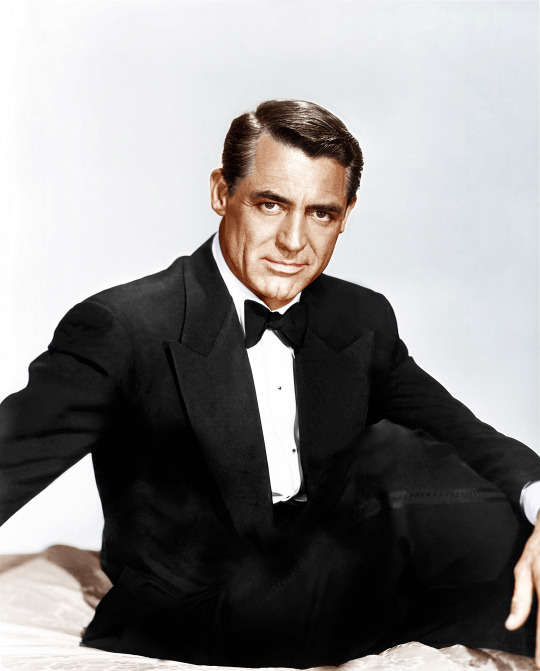
During studio-era classic Hollywood, the lives of stars, both in private and public, were almost always on display for peering eyes. Studios controlled nearly every aspect of their contract stars’ lives, closely guarding their public images and fabricating intriguing backstories filled with fictional details worthy of their own movie. Contract stars were a valuable commodity for a studio, and the more of them you had at your disposal meant more chances at successful movies, which then meant more recognition and most importantly, higher profits. Bringing a star under contract was a huge financial cost for a studio, but like any property (and that’s exactly what these actors and actresses were), the only way to make money is to invest it. While countless stars found themselves locked in unforgiving multi-year studio contracts that stifled their creativity and presented lackluster projects, a small handful, through smart business decisions and careful strategy, were able to break free of the traditional studio contract (well, as much as they could at that time) and carve out a more varied and creatively satisfying career. One of the actors who successfully broke out was the legendary Cary Grant.
But how did he do it? How did he break free of the system that made him, while also using it to his benefit? Throughout his life, including long before he ever stepped foot on a Hollywood sound stage and even after his retirement in 1966, Grant maintained tight control on his carefully crafted public persona and image, in the same way a Hollywood star today guards the details of their private life. And while Grant guarded his private life, too, he knew that his most valuable asset was being Cary Grant. At times, the public and private Cary Grant were one in the same; his name, his look and his voice were not only his livelihood, but his reputation, his legacy.

So many other things were out of his control: abandonment by his mother at the age of nine when she was institutionalized for mental illness (at the time he had been told that she left on holiday and eventually died; he didn’t discover the truth of her disappearance until he was in his early 30s, when he reunited with her); his father’s philandering; his difficulties in his personal and romantic relationships, including marriages to five women with all but one ending in divorce; and his desperate need to be liked by the general public. With all of those things bearing down on him, Grant made sure he had complete control of everything he possibly could. While his tenacious drive and dedication to create and maintain control of his image, regardless of the insecurities prompting it, proved to be worthwhile for Grant both personally and professionally, it was also groundbreaking for those in Hollywood who would follow him and his example, as he unintentionally set the template for career independence.
At a young age, Cary Grant (born Archibald Alexander Leach) was already showing the early signs of the great actor and performer he would later become. He naturally took to dance and the piano and was absolutely transfixed by live vaudeville shows and the one-reel comedies he saw in the movie theater. Grant wasn’t a great student in school, preferring to flaunt his acrobatic skills around his classmates and spend his free time hanging around backstage at the vaudeville theaters in his hometown of Bristol, England. After being expelled from school, Grant joined the famous Pender Troupe where he honed his acrobatic skills and learned about the importance of timing, particularly when working within an ensemble. Later, Grant’s ability to gauge how to use timing in his screwball comedies would prove to be an invaluable and unique skill, setting him apart from his fellow comedic actors. In 1920, when Grant was only 16, he left England to tour with the Pender Troupe in America. He soon realized that he longed for much more than a traveling acrobatic troupe could offer him, so he made the first of many shrewd career decisions that would pay off many times over.
When the Pender Troupe’s engagement at the New York Hippodrome came to an end, prompting their return to England, Grant elected to leave the troupe and remain in New York. For the next several years, he worked in vaudeville, touring all over the country and doing everything from singing and dancing to stand-up comedy. When he wasn’t on the stage, Grant was a street performer, including stilt-walking and juggling. And when he found himself short on work, he and friend Orry George Kelly (who would later become known as Orry-Kelly, famous in his own right for being one of Hollywood’s greatest costume designers) would set up on the sidewalks of New York City to sell neckties that Kelly had hand painted.
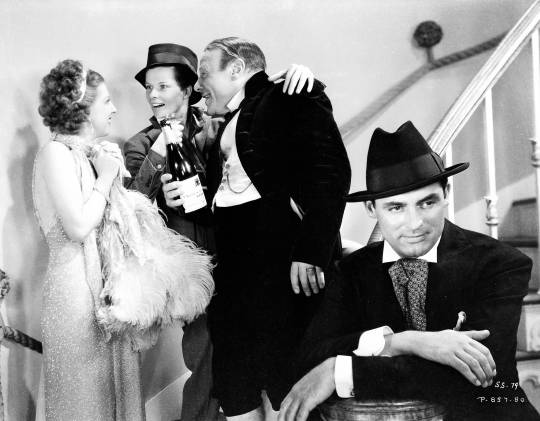
After a relatively successful and critically-praised performance in the Broadway play Nikki, Grant was invited to give a screen test with Paramount Studios. In his first on-screen appearance in the short film Singapore Sue (‘32), Grant was unremarkable. Sure, he was handsome, but he didn’t have that effortless style and ease that would later become synonymous with his name. Despite a rather lackluster start, Paramount signed him to a five-year contract, groomed and renamed him and cast him as tuxedo-clad arm candy for their top leading ladies, including Sylvia Sidney, Marlene Dietrich, Nancy Carroll and Mae West. However, Grant was deeply unsatisfied with the roles offered to him, most of them being the cast-offs of the studio’s more popular stars, like Gary Cooper and Fredric March.
Things changed for Grant when he was loaned out to the much smaller RKO Pictures for a chance to work with director George Cukor and star alongside Katharine Hepburn. The film was SYLVIA SCARLETT (‘35) and it finally gave Grant the opportunity to demonstrate his depth as a performer and his impeccable timing. At the end of his Paramount contract in 1936, Grant refused to sign another long-term studio contract, going freelance and opting for limited picture deals that would give him choice in his projects and the flexibility to work for several different studios. At the time, going freelance was practically unheard of and was considered career suicide. For many stars, not being tethered to a major studio contract would have certainly been the end of their careers. But Grant’s need to perform and share his unique talents would never be adequately fulfilled by a sweeping multi-year studio contract. Acting wasn’t just a job for Grant—his very life depended on it. So, in reality, this kind of risky move was really Grant’s only choice.

Grant’s instincts proved to be right, carrying him through an on-screen career that lasted over 34 years, with an image and legacy that has only endured and grown since his death in 1986. During his three decades in Hollywood, Grant worked with some of Hollywood’s best filmmakers, including multiple collaborations with key directors who would help shape the “Cary Grant persona”: Alfred Hitchcock, George Stevens, George Cukor, Howard Hawks, Leo McCarey and Stanley Donen. Grant, who was both a successful comedic and romantic leading man (as well as a fine dramatic actor, when given the chance), worked alongside incredible leading ladies, including Irene Dunne, Myrna Loy, Deborah Kerr, Grace Kelly and Ingrid Bergman. Unlike other popular romantic leading couples—such as Fred Astaire and Ginger Rogers, Myrna Loy and William Powell, and Katharine Hepburn and Spencer Tracy—Grant was never attached to one specific actress. While he made multiple films with some, he was never typecast as the “other half” in an on-screen partnership. Those decisions, coupled with his move to retire in 1966, while he was still in demand and before he lost his romantic leading man status by growing old on screen, undoubtedly contributed to his broad appeal with audiences and his enduring legacy.
The persona of Cary Grant was most certainly a product of the Hollywood star machine. But thankfully, Grant figured out early on how to make the machine work to his advantage, allowing all of us to bask in his beautiful masculinity, his charm and charisma, his hilarious comedic timing and even his caddish, dark side. In all of his years cultivating and safeguarding his image, to the extent that some even criticized his methods, Grant ensured that he would be forever remembered, perfectly preserved in celluloid. And for that, we should all be eternally grateful.
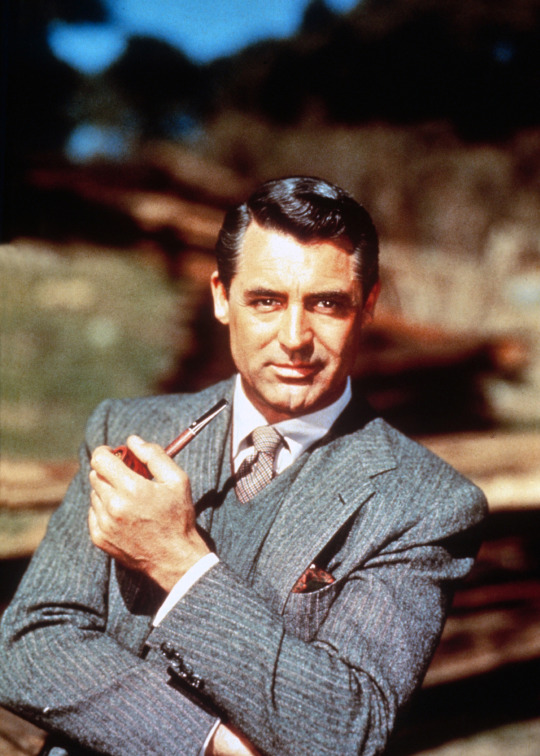
191 notes
·
View notes